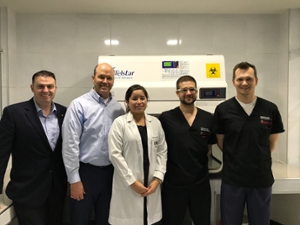
In April 2017, a team from the Moran Eye Center and Utah Lions Eye Bank (ULEB) completed an historic medical mission in Bolivia to help establish that country's first eye bank at the Instituto Nacional de Oftalmologie (INO), a charity eye hospital and clinic in downtown La Paz.
The trip marked a turning point for sustainable eye care in the country, and a new commitment from Moran's Global Outreach Division to provide yearly training to physicians there.
"Our first official outreach trip to Bolivia was in 2013," explained team leader and Moran cornea specialist, Mark Mifflin, MD. "By 2015, much-needed eye bank equipment donated by the LDS Foundation was in place, but it wasn't being used because of lack of training."
Along with Wade Mcentire, technical director of the Utah Lions Eye Bank (ULEB) and Moran fellows, Brent Betts, MD, and Severin Pouly, MD, the team delivered corneal tissue donated from several U.S. eye bank sources and spent a week performing 50 cataract surgeries and 30 corneal transplants, all the while training local ophthalmologists.
'A Landmark Event'
 Training in the art of eye banking, a complex process that requires collecting and carefully processing donated corneas, is especially critical. In countries where most residents have low incomes and the magnitude of corneal blindness is greatest, the availability of donated corneas is very low. This is due in large part to the lack of local eye banks, and to a lack of understanding about the donation process.
Training in the art of eye banking, a complex process that requires collecting and carefully processing donated corneas, is especially critical. In countries where most residents have low incomes and the magnitude of corneal blindness is greatest, the availability of donated corneas is very low. This is due in large part to the lack of local eye banks, and to a lack of understanding about the donation process.
During a week that also included lectures, classes, and intensive skills transfers, the team was able to strengthen ties with INO physicians who had spent time learning at the Moran Eye Center in Salt Lake City through its International Observer Program and then returned to Bolivia to continue their practices all in keeping with Moran's goal of creating sustainable eye care worldwide.
"Establishing an eye bank is a landmark event for the people of Bolivia," said Mcentire. "While Bolivian surgeons can always obtain tissue from U.S. eye banks, the key to sustained eye health is having locally recovered eye tissue. This allows for healthier and fresher tissue, but above all else, it allows the people of Bolivia to give the gift of sight."
Moving Forward
During the trip, Mifflin, Mcentire, and Joel Moya, MD, an INO physician and former Moran observer, met with Bolivia's deputy minister of health to "start the process of change" in eye care in that country.
"We still have a long way to go," said Mifflin. "There's a need better surgical training, which Moran can support with ongoing outreach trips mostly for cataract and corneal surgeries. They need more skills transfer in eye banking, which we can also support with visits, and we can send corneas."
An important element for success will be creating social change in the form of donor awareness. It's something the team will work on in with local officials.
"I think in 10 years, or maybe even five," said Mifflin, "Bolivia will have a functioning eye bank."
Bolivia
• Population: Approximately 11 million
• Ranks at or near the bottom among Latin American countries in several areas of health and development, including poverty
• Only country in South America without an eye bank
To view photos click here.